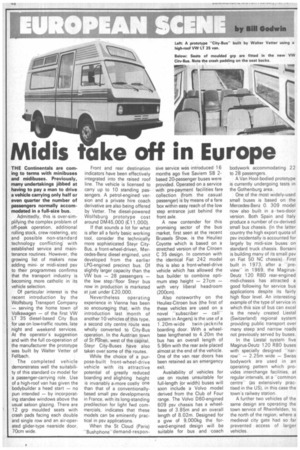Midis take off in Europe
Page 50

If you've noticed an error in this article please click here to report it so we can fix it.
THE Continentals are coming to terms with minibuses and midibuses. Previously, many undertakings jibbed at having to pay a man to drive a vehicle carrying only half or even quarter the number of passengers normally accommodated in a full-size bus.
Admittedly, this is over-simplifying the complex problem of off-peak operation, additional rolling stock, crew rostering, etc and possible non-standard technology conflicting with established service and maintenance routines. However, the growing list of makers now adding minior midi-sized psv to their programmes confirms that the transport industry is becoming more catholic in its vehicle selection.
Of particular interest is the recent introduction by the Wolfsburg Transport Company — serving the home town of Volkswagen — of the first VW LT 35 diesel-based City Bus for use on low-traffic routes, late night and weekend services. At the operator's suggestion and with the full co-operation of the manufacturer the prototype was built by Walter Vetter of Fel I bach.
The completed vehicle demonstrates well the suitability of this standard cv model for a passenger-carrying role. Use of a high-roof van has given the bodybuilder a head start — no pun intended — by incorporating standee windows above the usual saloon glazing. There are 12 grp moulded seats with crash pads facing each double and single row and an air-operated glider-type nearside door, 70cm wide. Front and rear destination indicators have been effectively integrated into the raised roof line. The vehicle is licensed to carry up to 10 standing passengers. A petrol-engined version and a private hire coach derivative are also being offered by Vetter. The diesel-powered Wolfsburg prototype cost around DM45,000 (£11,000).
If that sounds a lot for what is after all a fairly basic working tool, consider the technically more sophisticated Steyr CityBus, a front-wheel-driven, Mercedes-Benz diesel engined, unit developed from the earlier LPG-engined precinct bus. Of slightly larger capacity than the VVV bus — 28 passengers — the low step/floor Steyr bus now in production is marketed at just under £20,000.
Nevertheless operating experience in Vienna has been so encouraging that, with the introduction last month of another 10 vehicles of this type, a second city centre route was wholly converted to City-Bus operation. In the Austrian town of St Mien, west of the capital, Steyr City-Buses have also taken over some of the routes.
While the choice of a purpose-built front-wheel-drive vehicle with its attractive potential of greatly reduced boarding and alighting height is invariably a,more costly one than that of a conventionallybased small psv developments in France, with its long-standing predilection for light fwd commercials, indicates that these models can be eminently practical in psv applications.
When the St Cloud (Paris) -Bushphone-demand-respon
sive service was introduced 16 months ago five Saviem SB 2based 20-passenger buses were provided. Operated on a service with pre-payment facilities fare collection (from the casual passenger) is by means of a fare box within easy reach of the low step entrance just behind the front axle.
A new contender for this promising sector of the bus market, first seen at the recent Brussels Show, is the Heuliez Coyotte which is based on a stretched version of the Citroen C 35 design. In common with the identical Fiat 242 model this is also a front-wheel-drive vehicle which has allowed the bus builder to combine opti mum step height — 27cm — with very liberal headroom (200cm).
Also noteworthy on the Heuliez-Citroen bus (the first of these vehicles are used on a novel "'subscriber — call"' system in Angers) is the use of a 1.20m-wide twin-jacknife boarding door, With a wheel base lengthened to 4.20m the bus has an overall length of 5.96m with the rear axle placed almost at the end of the vehicle.
One of the van rear doors has been retained as an emergency exit.
Availability of vehicles for use on routes unsuitable for full-length (or width) buses will soon include a Volvo model derived from the Club of Four range. The Volvo D60-engined 609 psv chassis has a wheelbase of 3.85m and an overall length of 8.02m. Designed for a gvw of 9,000kg the forward-engined design will be suitable for bus and coach bodywork accommodating 22 to 28 passengers.
A Van Hool-bodied prototype is currently undergoing tests in the Gothenburg area.
One of the most widely-used small buses is based on the Mercedes-Benz 0. 309 model now also built in a two-door version. Both Spain and Italy produce a number of cv-derived small bus chassis. (In the latter country the high export quota of psv incidentally is accounted for largely by midi-size buses on standard truck chassis. Borsani is building many of its small psv on Fiat 50 NC chassis). First built in 1973, after a "previewin 1969, the MagirusDeutz 120 R80 rear-engined midi-chassis has attracted a good following for service bus applications despite its fairly high floor level. An interesting example of the type of service in which this size of bus can excel is the newly created Liestal (Switzerland) regional system providing public transport over many steep and narrow roads not previously served by buses.
In the Liestai system n five Magirus-Deutz 120 R80 buses with specially designed "narrow— 2.25m wide — Swiss bodywork are used in an operating pattern which provides interchange facilities, at regular intervals, at a -common centre(as extensively practised in the US), in this case the town's railway station.
A further two vehicles of the same design are operating the town service of Rheinfelden, to the north of the region, where a medieval city gate had so far prevented access of larger vehicles.








































































































